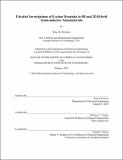Ultrafast Investigations of Exciton Dynamics in 0D and 2D Hybrid Semiconductor Nanomaterials
Author(s)
Powers, Eric R.
DownloadThesis PDF (25.35Mb)
Advisor
Tisdale, William A.
Terms of use
Metadata
Show full item recordAbstract
The development of hybrid organic-inorganic semiconductor nanomaterials represents a major advance towards highly tunable and efficient optoelectronic devices. These materials are comprised of multiple chemical constituents arranged in nanoscale geometries, and they exhibit emergent properties such as quantum confinement and enhanced Coulombic interactions. Photoactive nanomaterials have potential applications in lighting, solar, lasing, and quantum information. However, their complex chemistry and nanometer-scale dimensionality present a barrier to understanding and controlling their structure-function relationships. In this thesis, I utilize ultrafast pump-probe spectroscopy to study the fundamental properties of hybrid semiconductor nanomaterials. This technique allows the electronic and vibrational dynamics of these materials to be investigated with femtosecond time resolution, providing new insights into their underlying physics.
I first employ impulsive vibrational spectroscopy to study exciton-phonon interactions in silver phenyl selenolate (AgSePh), a recently discovered hybrid 2D semiconductor. Combining this time-domain Raman technique with frequency-domain non-resonant Raman scattering, I measure the vibrational landscape of the system and identify a subset of vibrational modes that couple strongly to excitonic transitions. Density functional theory calculations are then utilized to pinpoint specific atomic displacements which couple to the excitonic transition. An investigation of temperature-dependent photoluminescence reveals the connection between atomic scale dynamics and macroscopic properties, showing the 99 cm-1 mode strongly impacts emission frequency and linewidth in AgSePh. Finally, temperature-dependent impulsive vibrational spectroscopy is employed to probe vibrational anharmonicity in this material. These findings provide a roadmap for controlling exciton-phonon coupling in hybrid organic-inorganic semiconductors.
Next, I study charging and neutralization processes in lead halide perovskite nanocrystals (quantum dots) with transient absorption spectroscopy. A temperature-dependent study of CsPbBr3 nanocrystals reveals that charging occurs in a significant fraction of photoexcited nanocrystals (>10%), which then exhibit a microsecond neutralization lifetime at cryogenic temperatures. The temperature-dependent dynamics are modeled to extract a ~100 meV energy barrier to re-neutralization. Additionally, photocharging shows a sublinear fluence dependence, excluding Auger recombination as the initiator of this process, in contrast with traditional nanocrystal systems. These results help illuminate the underlying mechanism of charging in perovskite nanocrystals, guiding future synthetic advances to improve nanocrystal performance in lighting and quantum information applications.
Date issued
2023-02Department
Massachusetts Institute of Technology. Department of Chemical EngineeringPublisher
Massachusetts Institute of Technology